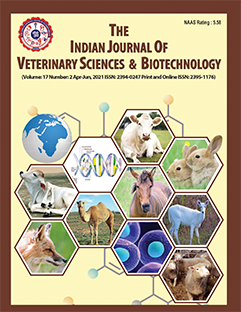Management and Prevention of Nasal Schistosomosis in a She-Buffalo: Clinical Insights
DOI:
https://doi.org/10.48165/ijvsbt.21.3.29Keywords:
Bovine Nasal schistosomosis, Schistosoma nasale, Boomerang shaped egg, Miracidium, Anthiomaline, Successful managementAbstract
Nasal schistosomosis (Snoring disease) is a snail born trematode infection of domestic and wild ruminants caused by Schistosoma nasale (Chandra Sekhar et al., 2021). This pathogen primarily affects cattle and buffaloes leading to significant economic losses in livestock dependent areas across Asia and Africa. Serious outbreaks of this disease among cattle and buffaloes have been reported in certain regions of India, viz., Tamil Nadu, Karnataka, Kerala, West Bengal (Sumanth et al., 2004; Agarwal, 2012; Ravindran and Kumar, 2012). Fresh water snail belonging to genus Indoplanorbis acts as intermediate host (Liu, 2010). Primary mode of transmission is through skin penetration when free swimming larval stage cercaria comes in contact with the ruminants in contaminated water bodies. Upon entering the definitive host, the parasite primarily affects nasal blood vessels. The main pathogenic effects are associated with the eggs that trigger granuloma formation through release of antigens that stimulate the host immune system, leading to a chronic inflammatory response in the nasal mucosa that may occlude the nasal passage.
Downloads
References
Agrawal, M.C. (2012). Schistosomes and Schistosomiasis in South Asia.
Fig. 4: Free escaped miracidium from the eggs of S. nasale in the nasal scrapings
Springer (India) Pvt Ltd., New Delhi, India, p. 351. Chandra Sekhar, Prasuna, K., Jahan Afroz, Khatoon, S., & Rao, G.S. (2021). Persistence of nasal schistosomiasis in cattle: A clinical case report. Journal of Entomology and Zoological Studies, 9(2), 1350-1352.
Jayalakshmi, J., & Sudha Rani Ch. Chowdary (2016). Prevalence, diagnosis and therapeutic management of nasal schistosomosis in bovines. Intas Polivet, 17(2), 524-525.
Liu, L. (2010). The phylogeography of Indoplanorbis exustus (Gastropoda: Planorbidae) in Asia. Parasites Vectors, 3, 57. Qadri, K., & Ganguly, S. (2016). Occurrence of Schistosoma nasale
infection in crossbred cattle: A case report. The IIOAB Journal, 7 (7), 10-11.
Rajamohan, K., & Peter, C.T. (1975). Pathology of nasal schistosomiasis in buffaloes. Kerala Journal of Veterinary Science, 6, 94-100. Ravindran, R., & Kumar, A. (2012). Nasal schistosomiasis among large
ruminants in Wayanad, India. The Southeast Asian Journal of Tropical Medicine and Public Health, 43(3), 586.
Roopali, B., Sateesh, A.G., Abhilash, B., & Dhabale, R. (2017). Successful therapeutic management of nasal schistosomiasis. Indian Journal of Veterinary Public Health, 4(1), 39-42.
Satbige, Ajay, S., Patil, N.A., Vaijanath, M., & Ravindra, B.G. (2018). Nasal schistosomiasis in a she-buffalo. Journal of Entomology and Zoological Studies, 6(4), 760-761.
Schwatz Christin, & Fallon Padraic (2018). Schistosome ‘‘eggs-itching’’ the host: immune dependent granuloma formation and egg excretion. Frontiers in Immunology, 9, 2492.
Soulsby, E.J.L. (1982). Helminths, Arthropods and Protozoa of Domesticated Animals. 7th Edn., English Language Book Society and Baillere Tindall, London, p.763-772.
Sumanth, S. D’Souza, P.E., & Jagannath, M.S. (2004). Study of the nasal and visceral schistosomiasis in cattle slaughtered at an abattoir in Bangalore, South India. Revue scientifique et technique. 23 (3), 937-942.
Downloads
Published
Issue
Section
License
Copyright (c) 2025 Indian Journal of Veterinary Sciences and Biotechnology

This work is licensed under a Creative Commons Attribution-NonCommercial-NoDerivatives 4.0 International License.




